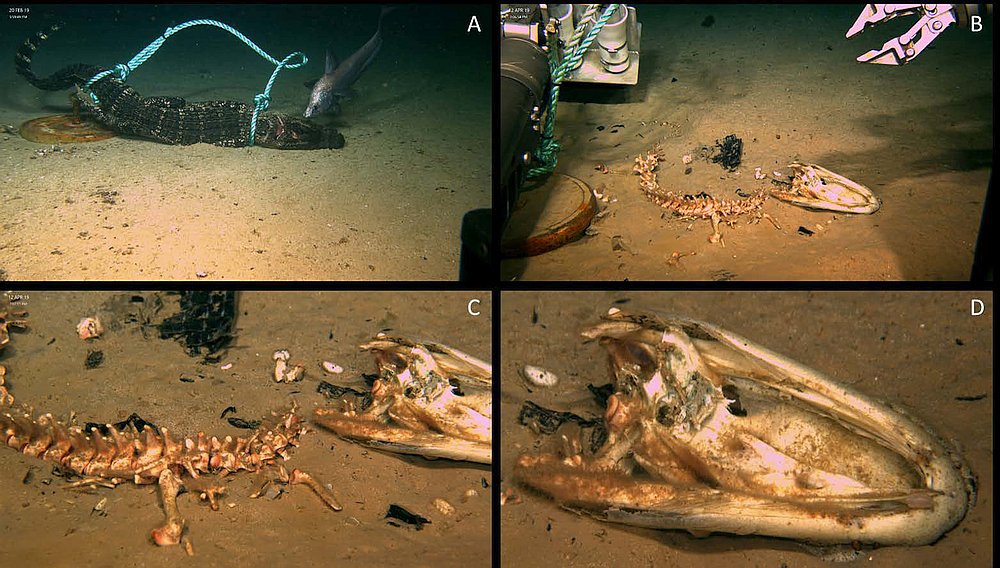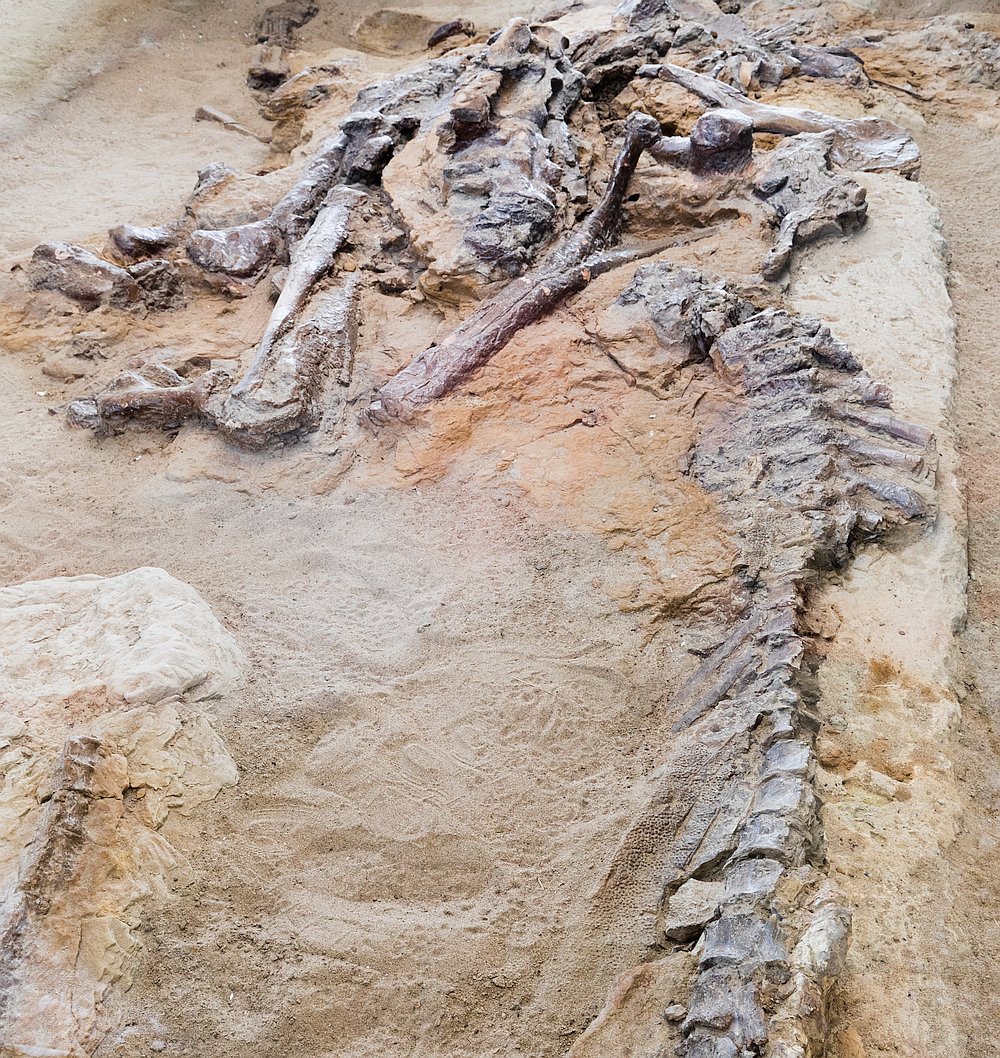| FOCUS | CREATION NEWS AND VIEWS |
‘Early Cretaceous’ dinos sank their teeth into … grass

In 2005, the discovery of the remains of various grass species in dinosaur dung caused something of a ‘time-travel’ problem for evolution (see creation.com/grass-eating-dinos). That’s because the evolutionary storyline mooted that grasses didn’t appear until after the dinosaurs had become extinct. So the new evidence forced a rewrite of their timeline. Nevertheless, some evolutionary scientists continued to hold to a ‘post Cretaceous’ origin of grasses.
But now the “earliest known grass fossils” have been found in duck-billed dinosaur remains from rocks classified as Early Cretaceous. Leaf surface pieces and phytoliths (microscopic structures made of silica) from at least two types of grass were discovered around the teeth.
One lesson from this is that evolutionary timelines are not ‘truth’ but prone to change. In contrast the Bible’s timeline can be trusted. Grasses were created about 6,000 years ago on Day 3 of Creation Week, preceding by three days the dinosaurs and all the other land creatures, so no wonder we find evidence that dinos ate grass. Logically, the fossil record is a legacy of the global Flood of Noah’s day about 4,500 years ago and its aftermath, not a ‘clock’ that can tell the time and order of origin of species.
- Yan Wu and 2 others, Dinosaur-associated Poaceae epidermis and phytoliths from the Early Cretaceous of China, National Science Review 5(5):721–727, 2018.
Dark matter still a mystery

Well known creationist physicist Dr John Hartnett has been very critical in CMI literature and elsewhere of the alleged stuff that astronomers call dark matter. He has said, “Its alleged existence is an admission that we don’t know something about our universe”, and has predicted that it will not be found, at least not in the exotic form and quantity needed.
In November 2019 the popular science magazine New Scientist had this admission on its front cover:
“DARK MATTER: We still haven’t found it. Our theories are falling apart.”
Commenting on this situation, Dr Hartnett says,
Add to that the mystery of ‘dark energy’ and the two components total 96% of the mass/energy content of the universe. But what makes it worse, we know nothing about these alleged entities. The simplest solution—as per Ockham’s Razor—is that they just do not exist. The big bang cosmological paradigm is wrong. It is based on the false notion that the universe created itself, without the Creator. It follows then that when fallen creatures use this false starting point, many contradictions will arise in any theory that tries to explain the universe. And finally someone is admitting it—their theories are falling apart.
Oldest fossils are nothing of the sort

In 1996, a rock that was thought to have somehow made its way to Earth from Mars was a media sensation as news outlets proclaimed “Life on Mars!” A microtubule or filament-like structure was thought to be the fossilized remains of some sort of primitive life. That’s because it was similar to alleged fossils on Earth that were claimed to be 4 billion years old.
Now a team from the University of Edinburgh has created similar-type structures in the lab that closely mimic the alleged Earth/life-on-Mars structures. They did this by mixing iron-rich particles with alkaline solutions that contained silicates or carbonates.
Researcher McMahon said, “These results call for a re-examination of many ancient real-world examples to see if they are more likely to be fossils or non-biological mineral deposits.” Of course, we agree. Indeed, if many of these ‘ancient-life’ examples turn out to be nothing of the sort, then it would be a serious dent for the idea of evolution of alleged primitive life billions of years ago.
See creation.com/life-on-mars.
- Solving fossil mystery could aid search for alien life on Mars, Engineering and Technology, 2 Dec 2019.
Human and ape saliva are drastically different!

Evolutionists say that humans and modern apes have descended from a common ancestor. However, a study on the saliva of humans, chimpanzees and gorillas shows marked differences. The researchers found that “humans produce a waterier saliva, containing less than half the total protein” than that of great apes. They also discovered “unique protein profiles in humans that were distinct from those of nonhuman primates.”
Why would humans produce more-watery saliva? One suggestion is it helps us when doing what chimps and gorillas never do—talking or singing. (Consider how hard it would be to do either well if suffering from a dry mouth.)
The researchers speculated that our diet and/or oral bacteria helped our saliva to ‘evolve’ to be ‘unique’ in regard to the ‘other apes’.
These unique differences took the researchers by surprise. But there should be no surprise, because humans and great apes were created separately on Day 6.
- Thamadilok, S. and 7 others, Human and non-human primate lineage-specific footprints in the salivary proteome, Molecular Biology and Evolution msz223, 15 Oct 2019.
Narwhal—the ‘unicorn’ puppy

An unusual puppy found on a freezing cold street has an extra tail growing in the middle of its forehead. Taken in by the Missouri-based Mac’s Mission, the beagle-mix puppy was aptly named Narwhal due to its strange appendage. When the picture of the puppy was released some questioned if it had been photoshopped. Upon closer examination the tail was found not to have any bones inside nor any muscles attached.
While it serves no purpose, it has not been removed as it currently does the pup no harm. Some maintain that the extra tail is due to a mutation, while others have suggested that it is actually the remains of the puppy’s parasitic twin.
Many evolutionists often point to mutations as the source of new information that allows evolution to occur. However in this case, if the tail was caused by a mutation, there are no new genes, or information. Instead, it is simply a replication (albeit in the wrong place) of pre-existing information in the pup’s genome.
The tail also confers no advantage to the pup, and indeed as it grows it will have to be monitored as it may become a nuisance to its vision and have to be removed. While huge numbers of people offered to adopt the adorable pup, the mission decided to keep the dog to train him as a therapy dog.
- Preston, E., Tail on Narwhal the unicorn puppy’s head could really be parasitic twin; independent.co.uk, 16 Nov 2019.
Dogor the frozen puppy dog

A well-preserved puppy was found frozen in the Siberian tundra of the Yakutsk area (Russia). Assigned to the Upper Palaeolithic era, this dog supposedly died 18,000 years ago. Similar to some mammoths and other mammals found in the permafrost, the canine still has its body hairs intact.
Genetic research is yet to show what species it is. But the very fact that the DNA might be studied hints that this furry Friend (the meaning of its Yakut name ‘Dogor’) is much less than 18,000 years old, as DNA is a notoriously unstable molecule.
The report claimed support for evolution: “One theory is that the beast could represent a transitional stage from a wolf to a dog.” Nowadays, biologists recognize the domestic dog (Canis lupus familiaris) is simply a subspecies of the wolf (Canis lupus). Of course, this fits just fine with the biblical view because dogs and wolves (along with coyotes, dingos, jackals, etc.) are part of the same created kind. A wolf-like pair on Noah’s ark gave rise to all the canine variety that we are familiar with.
- Stewart, W., PAWFECT Frozen ‘puppy’ with whiskers and velvety nose still intact found in Siberia 18,000 years after it died; thesun.co.uk, 25 Nov 2019.
NASA animation exposes ice age land bridges

Have you ever wondered what a map of the world would have looked like during the Ice Age? An upgraded NASA video can give you a glimpse into that past by slowly draining the water from the world’s oceans revealing the incredible landscape underneath.
James O’Donoghue, formerly of NASA, and currently of the Japan Aerospace Exploration Agency (JAXA), edited the timing of the NASA animation and added a depth gauge to show how much had been drained away as it accumulated on the land as ice. (The animation does not show these huge ice sheets at the northern and southern portions of the globe.)
“Rather surprisingly, there’s a lot of undersea landscape instantly revealed in the first tens of meters,” said O’Donoghue. “When the last ice age occurred, a lot of ocean water was locked up as ice at the poles of the planet. That’s why land bridges used to exist. Each of these links enabled humans to migrate, and when the ice age ended, the water sort of sealed them in.”
Biblical creationists have long proposed that after the Noahic Flood some 4,500 years ago, there was an Ice Age lasting between 500–700 years, which occurred as a direct result of the Flood (see creation.com/ice-age).
The exposed land bridges during this period not only facilitated human migration, but animal migration also. This animation offers a peep back at the world that our ancestors navigated which now lies under a watery abyss.
- McFall-Johnsen, M., NASA slowly drains the oceans in an incredible animation, revealing hidden underwater mountain ranges and ancient land bridges, businessinsider.com, 2 Feb 2020.
Dead alligators on sea floor did not become fossils
Researchers wanted to know what would happen to the bodies of three dead alligators, Alligator mississippiensis, if they dropped them at the bottom of the sea. They were placed 2,000 m (6,600 ft) down in the Gulf of Mexico. When the scientists returned 51 days later, what they found left them stunned. The first alligator had been eaten down to its bones, and was covered in a brown fuzz. They later discovered that this brown fuzz was a bone-eating worm, called Osedax, consuming the ‘gator remains. The second alligator, in less than 24 hours was being devoured by giant isopods, Bathynomus giganteus. And the third alligator carcass was totally missing. Calculations suggested that “the bite strength needed to cut cleanly through our rope was consistent with that of a large shark.”

The myth of animals dying and falling to the bottom of the sea where they will be slowly covered in sediment and fossilized is still widespread today. This likely explains the scientists’ surprise at an outcome which is really consistent with common sense. As this study clearly shows, unless animals are very rapidly covered by sediment after death, predation and decay will prevent their preservation.
The conditions needed for the large-scale fossilization observed in sedimentary rock layers all over the earth were present in the Noahic Flood only 4,500 years ago.
See also creation.com/dead-crocodiles.
- McClain, C.R., and 4 others, Alligators in the abyss: The first experimental reptilian food fall in the deep ocean, Plos One, 20 Dec 2019.
- Burton, B., Dead alligators dropped into the sea lead to a surprising find; msn.com, 12 Jan 2020.
Insect quickly preserved in opal


A piece of opal containing a preserved insect has recently been found on the island of Java, Indonesia. Such an incredible thing has never been seen before. Opal is a colourful gemstone composed of silica (similar to window glass) with a small amount of water in its chemical structure.
Insects have often been found in amber (technically not a gemstone)—originally sticky tree resin. During the global Flood, countless uprooted and damaged trees exuded resin in which animal and plant remains became trapped. Even scientists who don’t believe in a global Flood acknowledge that the resin must have hardened quickly.
However, opal is widely believed to form very slowly from watery solutions over huge time periods. Yet the Javanese insect was obviously quite quickly preserved before decay could set in. The opal’s authenticity was confirmed by the Gemological Institute of America.
Some scientists, anxious to hold onto long-age belief, speculate the insect was first trapped in amber, which later transformed into opal—but there is no evidence for this.
Australian creationist Dr Len Cram, who earned his PhD from research into opal formation, observed the colours of opalescence beginning to form in his solutions in weeks, and estimated that complete hardening into gem-quality opal would take only decades. The new insect discovery suggests that, under ideal natural conditions, even faster rates of formation are possible. This makes complete sense in the light of the Bible’s young age for the earth.
- Fossilized insect discovered not in amber, but in opal, geologyin.com, 23 Feb 2019.
- Pickrell, J., Strange fossil may be rare insect preserved in gemstone, nationalgeographic.com, 30 Jan 2019.
- Hartnett, J., Opalized fossils and pseudo-fossils, Creation 39(4):52–53, 2017; creation.com/opalized.
Human bone disease found in dinosaur

A disease known medically as Langerhans cell histiocytosis (LCH) can appear suddenly in people, mostly children aged 2–10 years. LCH-related bone tumours can be “very painful”, but fortunately the disorder is rare and disappears without intervention in many cases.
Recently researchers studying a juvenile hadrosaur (duck-billed dinosaur) fossil noticed distinctively-shaped cavities in two of the tail vertebrae. They suspected these bone defects were tumours. Sure enough, advanced micro-CT scanning of each vertebra enabled the researchers to assess the 3D mesh surfaces of the tumours, blood vessels, and bone surface. “The hadrosaur pathology findings were indistinguishable from those of humans with LCH,” the researchers observed. They concluded that “the disease is not unique to humans” and “it has survived for more than 60 million years.”
There’s an important message here for Christians who, though perhaps anti-evolution, think the ‘60 million years’ is benign, and that the Bible’s Creation/Fall/Flood 6,000-year timeline is negotiable. Accepting millions-of-years puts LCH and other human/dino diseases (e.g. see creation.com/dinotumour) into the world before Adam sinned, nonsensically turning God’s pre-Fall ‘very good’ creation (Genesis 1:31) into a ‘very painful’ one. Putting fossils before the Curse/Fall defrauds Christians of a coherent answer to the ‘problem’ of death and suffering (see creation.com/death). Ditch the millions of years.
- Tel Aviv University, Disease found in fossilized dinosaur tail afflicts humans to this day, physorg.com, 11 Feb 2020.
- Rothschild, B. and 4 others, Suggested case of Langerhans Cell Histiocytosis in a Cretaceous dinosaur, Scientific Reports 10:2203, 2020.
Rock coconut

Visitors to the office of CMI-Australia’s Managing Director (CEO), Dr Don Batten, might notice a curious, round ornament on his desk. Picking it up, one notices its heaviness—around 4½ kg (10 lb). It soon becomes apparent, turning it over in the hands and examining the shape and texture, that it’s actually a coconut—but made of solid rock!
It was found on the northwestern shore of the island of Guadalcanal in the Solomon Islands (near the capital Honiara) in the 1980s and given to a missionary couple living there. Crops are grown under coconut palms by villagers in the area, and the coconut was likely buried at shallow depth, and subsequently found again years later, during the digging of crops. The missionaries used the heavy coconut as a doorstop for many years, and recently gave it to Don.
It is completely petrified (turned to stone). There doesn’t appear to be a single fragment left of the original woody tissue. Also, there are no signs of decay, weathering, or animal activity. Thus, it must have been changed into stone very quickly—before there was time for any of these things to occur.
Normally, coconuts that aren’t eaten simply rot away. However, dissolved rock minerals in the ground water petrified this coconut during the time it was buried. There is what looks like a relatively sharp cut mark on the coconut. That would suggest its origin is likely after steel knives and machetes were introduced to the region, i.e. rather recent.
This helps demonstrate once again that petrification is a rapid process—as has been confirmed many times. Millions of years are definitely not needed to turn organic remains into solid stone!
Why would god create coronavirus?
It comes as a shock to many people when they hear it, but most viruses are good for you and good for the environment. Yet, Covid-19 is clearly not good. From a big picture point of view, Christians see all evil and sickness in the world as related to the Fall of mankind, caused by the disobedience of the first man, Adam.
The initial creation had no disease, yet diseases have arisen over the past 6,000 years. Thus, the emergence of another SARS-like virus is not a surprise. The Spanish Flu killed tens of millions of people in the 1918–1920 pandemic. Yet, it quickly weakened, becoming no more dangerous than the seasonal flu before eventually going extinct in 2009. But the coronavirus is not the flu—we cannot wait decades for genetic entropy to take its toll. We need to listen to the expert advice we are being given. We also need to do our civic, and biblical, duty to protect others and ourselves from infection.
Viruses are part of God’s created order. They play many beneficial roles. Yet, we live in a sin-cursed world with much suffering, death, and disease. God has promised us neither long life nor good health. But He has promised to redeem our disease-wracked bodies. Thus, the hope of Christianity is not ultimately in vaccines or cures, but in complete healing and wholeness in the New Heavens and New Earth. In the meantime, let’s use wisdom and good health practices in this difficult situation.
- Carter, R., Coronaviruses in creation, creation.com/covid-19, 6 Feb 2020.


Readers’ comments
Comments are automatically closed 14 days after publication.